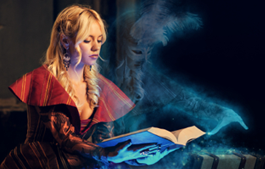 In this category you will find a selection of blogs from our authors.
In this category you will find a selection of blogs from our authors.
Blogs
Spotlight on Writing Horror with Gwendolyn Kiste and Scarlett R. Algee – Juliana S Mills
 Horror narratives are an integral part of our human history. Folktales have dark tendrils that go back for centuries. The Ancient Greeks created gods out of fear and terror. Every culture has a bogeyman, a gashadokuro, a strigoi. From the oral storytelling of the past to the modern day campfire tale, scary stories are everywhere.
Horror narratives are an integral part of our human history. Folktales have dark tendrils that go back for centuries. The Ancient Greeks created gods out of fear and terror. Every culture has a bogeyman, a gashadokuro, a strigoi. From the oral storytelling of the past to the modern day campfire tale, scary stories are everywhere.
Even epic tales of glorious deeds would be nothing without that undercurrent of fear. Remove the ringwraiths from The Lord of the Rings and half the tension immediately falls away. Without a White Witch to face, The Lion, The Witch and the Wardrobe is just a tale of talking animals. And A Game of Thrones without the White Walkers is simply a rather bloody story of political intrigue.
In literature, horror fiction harks back to eighteenth century works such as The Castle of Otranto by Horace Walpole, with nineteenth century gothic novels like Mary Shelley’s Frankenstein and Bram Stoker’s Dracula cementing the genre. By the late 1800’s, horror had already hit the (silent) screen, and horror as a film and TV genre is still wildly popular today.
But what does it take to write a good horror tale? It’s not enough to just throw in a few monsters and things that go bump in the night and hope they’ll do the job. Crafting a good scary story – one that gets under your skin and keeps you awake at night – is an art. My two guests are experts in that creep factor, and they’re here to point your ghosts and ghouls in the right direction.
Gwendolyn Kiste is a speculative fiction author whose work has appeared in a wide range of publications. Her short story collection And Her Smile Untether The Universe was a finalist in the 2018 Bran Stoker awards. She is the author of Pretty Marys All In A Row, a dark fantasy novella (Broken Eye Books, 2017) and her upcoming novel debut, The Rust Maidens (JournalStone, 2018).
Scarlett R. Algee writes speculative fiction and designs steampunk jewelry. Her work has appeared in a number of publications, including Morpheus Tales, Sirens Call, and Zen of the Dead. She is currently a submissions reader and chapbook editor for Sanitarium Magazine. Her stories can be found in several anthologies such as The Haunting of Lake Manor Hotel (Woodbridge Press, 2016).
The Eye of the SF Inspiration Storm – Rosie Oliver
 The eye of a storm produces calm for a brief few moments from the battering of the cyclone, hurricane, tornado, whatever form of storm happens to be passing by. It’s no different for those writers who just come up with one idea or inspiration after another. There is always that brief interlude of calm before the writer hurtles words onto their blank page.
The eye of a storm produces calm for a brief few moments from the battering of the cyclone, hurricane, tornado, whatever form of storm happens to be passing by. It’s no different for those writers who just come up with one idea or inspiration after another. There is always that brief interlude of calm before the writer hurtles words onto their blank page.
So what do I mean by all this? Let me give you an example.
Last year I completed a short story, which was for the plot line too short. I had cut it off in its prime and I knew it. So sensibly I put it to one side, letting it wither in the ‘retired stories’ heap. Only it kept calling to me. It had that spark at the start that pointed to something better, much better. Still I ignored it until a few weeks ago, when I sat down to extend it.
First scene, minor edits, tick. Second scene, heavy editing, but plot stays the same. Third scene, completely written from scratch. The typing had taken on a life of its own, taking the story in a direction I had not anticipated. I suddenly found my protagonists had deeper motivations that were overtaking the ones I had written in the original version. The story was becoming richer and far more human. Worse, I was even improving the details. For example – I had the doctor wearing glasses for psychological reasons, but decided that glasses were also acting as life sign monitors of the patients he was talking to, which added a richness to the world building. But the writing for now has ground to a halt while I try to work out where the heck the story is heading. Its main plot line is no longer the same. Then original version’s main plot line has turned into a subplot! I know that while I sit back, this is the calm of the eye of the storm.
Sex on Wings – Jo Zebedee
 I’ve always had a soft spot for a nice, sexy space pilot. I blame Han Solo for it, mostly, but Barbarella – all thigh-high boots, wide-eyed and shocked by the evil Dr Durand-Durand – has something to answer for, too.
I’ve always had a soft spot for a nice, sexy space pilot. I blame Han Solo for it, mostly, but Barbarella – all thigh-high boots, wide-eyed and shocked by the evil Dr Durand-Durand – has something to answer for, too.
It’s not just the sexy ones; I even like the Buck Rogers of this world, and the never-seen outside of the pages of a book, Ellie Quinns. For me, frankly, no space opera is complete without a space pilot, blaster hip-holstered, dashing, irreverent, and unpredictable. (There might be predictable ones out there; they’re not real space pilots. Ever. No matter how low their intimate voice is, or how their eyes flash, they don’t know their landing bay from their orbital habitat.)
So, why do space pilots equal sci-fi to me?
Firstly, full disclosure. I say science and I say fiction and they’re not equal. For me it’s three quarters fiction and one quarter science, half of which is dodgy. I used to be embarrassed about that. What sort of sci-fi writer couldn’t give a stuff that faster-than-light travel isn’t possible, or that you can’t hear sounds in a vacuum? Surely these things matter? And they do, to an extent – mainly to ensure I’m not laughed at too badly. But, frankly, being constrained by little details like the speed of light doesn’t get you to the end of the Kessel Run in a half-decent time, and I always fancied a run at that.